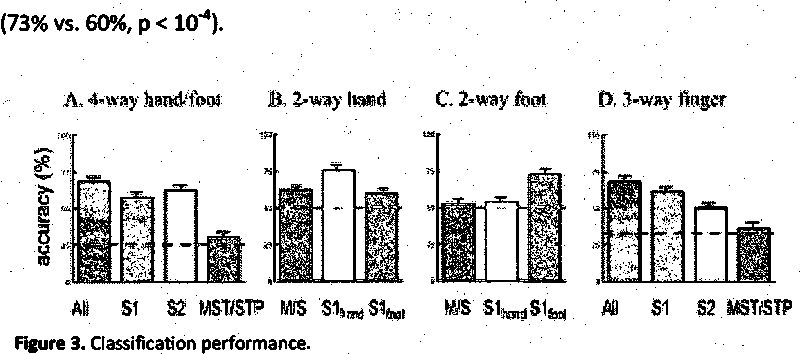79
for foot vs. hand stimulation. The ability of both ROIs to perform two-way classification
(left vs. right) was tested (Fig. 3B,C). Slhand was better at predicting side of hand
stimulation than side of foot stimulation (75% vs. 54%, p < 0.001). Slfootwas
significantly better at predicting side of foot stimulation than side of hand stimulation

A. Performance for four-way classification (right hand, left hand, right foot, left foot). The mean
performance of the classifier when classifying single trials in a scan series not used for training,
averaged across 8 subjects (error bars shows the SEM). The gray bar shows the performance when
the classifier was trained and tested on voxels in all ROIs; colored bars show performance when
classifier was trained and tested only on voxels in a single ROI (SI, S2, MST∕STP). Chance
performance was 25% (dashed line).
B. Accuracy of two-way classification (left hand vs. right) in three ROIs.
C. Accuracy of two-way classification (Ieftfootvs. right foot) in three ROIs.
D. Accuracy of three-way classification in experiment 2 (thumb vs. middle finger vs. pinky finger).
InapreviousstudyjMsTsignificantlypreferredhandstimuIationtofoot
stimulation, perhaps because of a role in eye-hand coordination (Beauchamp, et al.
2007). We hypothesized that the relatively poor MST∕STP performance in 4-way
classification might reflect differential performance on hand and foot classification.
Therefore, the ability of MST∕STP to classify hand stimuli (left vs. right) and foot stimuli
(left vs. right) was also separately tested. MST∕STP classification performance was
More intriguing information
1. The storage and use of newborn babies’ blood spot cards: a public consultation2. The name is absent
3. LOCAL CONTROL AND IMPROVEMENT OF COMMUNITY SERVICE
4. Evidence-Based Professional Development of Science Teachers in Two Countries
5. AGRICULTURAL PRODUCERS' WILLINGNESS TO PAY FOR REAL-TIME MESOSCALE WEATHER INFORMATION
6. Smith and Rawls Share a Room
7. THE USE OF EXTRANEOUS INFORMATION IN THE DEVELOPMENT OF A POLICY SIMULATION MODEL
8. The name is absent
9. An Incentive System for Salmonella Control in the Pork Supply Chain
10. Beyond Networks? A brief response to ‘Which networks matter in education governance?’